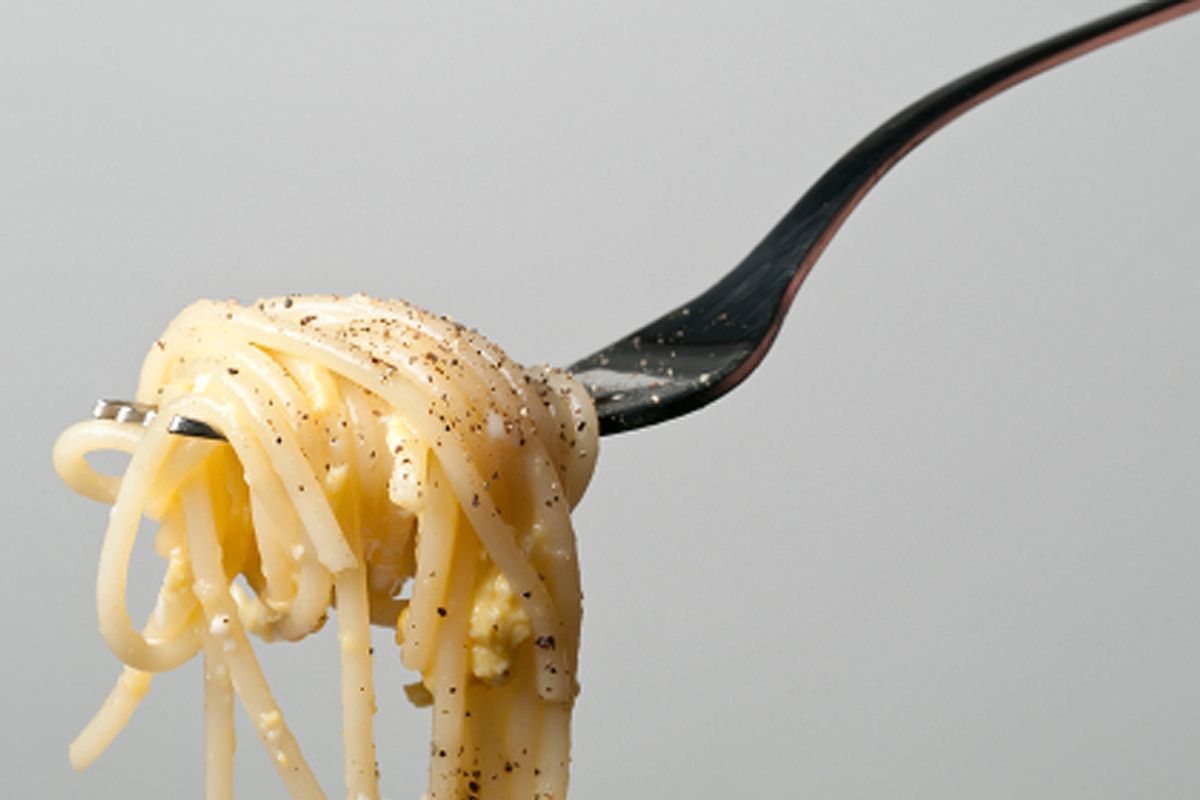The food of Rome is the gustatory reflection of a city whose history encompasses the glory of an empire and the squalor of a tiny provincial backwater, the excesses of Caligula and the holiness of saints, the refinement of court cuisine and the simple, earthy cookery of pilgrims and the poor. It's almost shockingly powerful, almost primal, revolving around organ meats, garlic, black pepper, juniper berries, sausage, pork and cheese. Eating a Roman meal is like experiencing an earthquake or an orgasm or Mardi Gras.
In my mind, no dish better encapsulates the experience of Roman cuisine than Spaghetti alla Carbonara -- the Roman charcoal industry's gift to the world. As the story I've been told goes, the charcoal sellers lived in the towns in the hills of Lazio outside Rome, cutting wood and charring it before carrying it in sacks down to the city to sell. The work was almost unbearably physical, and demanded hearty food to keep up one's energy -- hence, the birth of this almost unbearably rich pasta dish.
How much of that is truth and how much the product of the Roman love for poetic fabrication I don't know, but whatever its history, it's my favorite meal on Earth, a marker of important events in the same way that others use champagne or cigars. When served, conversation around the table ceases, replaced by moans and grunting. It's a pleasure too good to ever be called guilty.
A note on ingredients: I call for pancetta, an air-cured Italian pork belly that's a cousin to bacon. I love its chewy sweet-saltiness, but most Romans would insist that you use guanciale, cured pork cheek, whose soft, buttery unctuousness produces a different texture and effect. Pancetta is widely available, usually presliced in thin sheet; I prefer to buy it from an artisan salumi producer that sells it in a cylindrical roll that allows me to cut it into small dice. Guanciale is less widely available. Both can be bought online from Boccalone, a San Francisco artisan salumeria, and in well-stocked Italian markets.
Also, this recipe uses minimally cooked eggs. All the usual caveats apply; I recommend sourcing eggs from responsible producers that are unlikely to have salmonella problems, but if you're worried about uncooked eggs, this may not be the recipe for you.
Spaghetti alla Carbonara
*Mise en place is essential for this recipe. Have everything prepared before you start!
Ingredients
- 6 ounces pancetta or guanciale, cut into ¼-inch dice
- 1 tablespoon olive oil
- 2 whole eggs plus 3 egg yolks, beaten together with ¼ cup water
- ½ cup freshly grated pecorino romano (a hard, salty goat cheese)
- ½ cup freshly grated Parmigiano-Reggiano
- 1 teaspoon coarsely ground black pepper
- 1 pound good-quality spaghetti -- splurge for the good stuff, and look for a rough, textured surface; the sauce will adhere better.
Directions
- Heat the oil in a high-sided skillet over medium heat and gently cook the pancetta/guanciale until the fat has fully rendered and the meat is just barely crisp but still chewy. Don't fry it until it's completely crisp! If the pancetta is done before the pasta, set it aside. DO NOT drain the rendered fat under any circumstances.
- Cook the pasta until al dente, reserving a small amount of the cooking water.
- Just before you drain the pasta, take a big sip of wine, and make sure you've got two pasta forks or other implements for tossing pasta quickly. If you took the pancetta off the heat early, put it back on the burner and heat it up so the fat is bubbling, then take it off the heat again and put it on a cutting board or other heatproof surface.
- Now, everything happens very fast; you're relying on the latent heat of the pasta and pancetta to cook the sauce. Drain the pasta in a colander and dump it into the skillet at once, while it's still hot; dump the cheese and pepper on top of that, and pour the beaten eggs over the whole mess -- one, two, three, very fast! Then, immediately, toss that pasta like you've never tossed before. You want the eggs to mix with the cheese and coat the pasta smoothly, not hit the hot fat at the bottom and turn into globs of scrambled eggs. This is where I usually drop stuff and create lots of drama.
- Serve immediately, just as soon as the eggs set on the pasta, in warmed pasta bowls, passing extra cheese and pepper as desired -- this recipe quickly congeals when cold, so scream "Mangia! Mangia!" at anybody inclined to linger over their salad. Sit back, drink wine, and enjoy the chorus of quiet, deeply moved profanity and moaning.
Quick Reference Steps:
- Sauté pancetta until just crisp but slightly chewy. Meanwhile, cook pasta until al dente.
- Heat up pancetta if taken off heat, drain pasta.
- Dump pasta, cheese, egg mixture, pepper into skillet and toss with hot pancetta.
- Serve immediately.

Shares